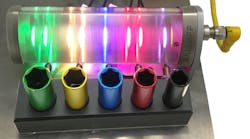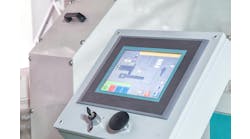In the current manufacturing climate with the COVID-19 pandemic first and foremost on everyone’s mind, the need to produce more product with, in most cases, fewer people to man the lines is a great concern for all of us. Getting lines running, and keeping them running, is of the utmost concern. In an ideal world, a line starts up and just keep producing widgets until you don’t need widgets any more. A more practical view of the world would be that, no matter how well planned out, a line is going to stop at some time. Most of those times, it is an unplanned stop, and the goal is to quickly identify the issue and resume operation with as little downtime as possible. There are many tools in the designer’s toolkit to diagnose and annunciate the cause of an unplanned stop, but the best first line of notification remains the venerable stack light.
Before the invention of a graphical user interface, alarms were annunciated by means of signal lights on a control panel. Depending on the type of annunciation panel, some designs would incorporate a physical outline of the machine on a flat surface to which signal lights were installed at key locations to represent the location of the source of the error on the machine. These were called mimic panels. One has to look no further than vintage television shows like Star Trek to get a good visual of the outline of the starship with lights blinking off and on to show where the emergency situation had occurred.
The tremendous advancement in signal technology and networks has made it easier and less costly to deploy multiple human-machine interface (HMI) units in a control system. HMIs have improved by leaps and bounds. The most taxing part of a graphical display used to be the process of mapping elements on the screen to the tag points in the PLC. The newest of HMI development software has the capability of looking at the latest version of the PLC tag database and presenting those tags directly to a selection list on the HMI software. The latest generation of my favorite brand of HMI now includes a pair of PLC instructions that automatically populates the HMI alarm function. Tags and string data, once entered in the PLC, magically appear on the HMI, so there is no need to re-enter the tag and string (or trigger bit) in both devices. The instruction set has both a digital and analog version that includes settings for local or remote acknowledge bits, local or remote reset bits, delay on timer, duration timer and the ability to make the alarm condition active high or active low, all within the parameters accessed via the programming software. Analog alarms add low, high, low-low and high-high alarm levels to the digital version. All of this leads to better alarm annunciation on the HMI. However, the fact remains that the user/operator must still be notified in some manner that the system has encountered a fault condition. For this purpose, the stack light is still the best way to draw attention to the need for operator interaction.
One of the most recognizable forms of a light stack is the traffic signal light—green for go; yellow to slow down; and red to stop. These concepts translate well over to the stack light of a control system where green is still “go” or “going” and red is still “stop” or “stopped.” Yellow changes to be manual mode or jogging or a variety of other meanings. Other colors are added to provide additional information to the operator. Blue, for instance, could be used to indicate a material or consumable supply shortage. The point of the stack of various colored lights is to provide first-response information to the user.
While the primary troubleshooting sense we use is vision, we don’t know to look at something unless we are drawn to the need. This is where the alarm horn comes into play. No matter what other sense we are using, the introduction of a sound to the environment in which we are working is the most efficient means by which our attention is drawn to another focus. Sound is cast out in every direction and can be received in the same manner, whereas our sight is limited by the direction in which we are facing and further can be limited by the object in focus at that moment.
That is the function of a stack light. A horn or buzzer to draw our attention to a particular focal point followed by a display of lights to give us a clue as to what is causing the source of the interruption to the process. What we do with those basic tools and the value-added functions that automation vendors have added to the basic stack light can provide important first-response information to a control process. For instance, a solid red light could mean a safety device has been activated. This could be an e-stop button, a guard door open or a light curtain tripped. That same light could flash to indicate a fault condition but not caused by a safety device. A solid light could indicate a machine that is in a run condition, while a flashing green light could indicate that the machine is running but a piece of downstream equipment is not. A flashing blue light could indicate that a consumable material, such as glue or film, is running low while a solid blue light could indicate that a consumable material supply is exhausted or below a minimum level. A momentary or pulsing horn or buzzer can be used to draw attention to any of the above conditions or can be used to indicate that a machine is starting up but hasn’t produced motion yet. A well-thought-out deployment plan at the plant-floor level should involve creating a standard for the workplace and then making sure that all new equipment comes with the light functions already programmed and any retrofits add this same commonality to promote efficient work flows and problem-solving techniques.
From humble beginnings, great things are happening with stack lights. Earlier light modules employed incandescent bulbs that frequently burnt out. The need to replace these bulbs was a necessary part of a preventive maintenance program. The transition from alternating-current to direct-current control systems brought about the ability to use light emitting diodes (LEDs) as a means of providing status indication. The great part about using an LED is it lasts pretty much forever. Another great bonus of the LED is big things come in small packages. A single light module can contain multiple colors of LEDs in a very small footprint. One could put multiple colors in the same light module, reducing the space impact on the machine. With smaller packages comes a reduced price and elimination of the need to frequently replace bulbs.
Newer LED light modules have incorporated multiple LEDs of the same color in a single light module with a reflector behind the lights to create a signal of much higher visibility than the original version. With the cost reduction and one-time purchase (LEDs last forever, pretty much) it is economical to put multiple stack lights on the same machine for much greater visibility and improvement on drawing attention to the function of the machine or process. Some of the latest product offerings from vendors are quite inventive.
One manufacturer has added a recordable annunciation to the horn feature. This unit can play the usual sound tone but can also record a spoken message that can be played back when the horn is activated.
[javascriptSnippet ]
[pullquote]Multiple vendors have added wireless versions of their stack lights that communicate via Bluetooth or Ethernet with the host machine. Long-life batteries keep these active, or they can be locally powered but receive the trigger command pulse from a remote controller via the network connection.
Other vendors have multi-conductor quick-disconnect versions that allow the programmer to use a combination of output signals to trigger pre-programmed functions in the stack light. In this version, the nominal red-yellow-green lights can be lit in combination to make more colors.
Many of the vendors of stack lights have incorporated input devices into the annunciation light to make it interactive. Different colors will prompt action from the operator and the touch function of integrated input device provides feedback to the PLC to indicate a response to the indicated action.
Ultimately, a control system depends on a well-thought-out plan of interaction with the operator. Graphical display terminals are only effective if the operator knows when to focus attention on what is being displayed. The stack light will always be a good first call to action and is especially important in a crowded production environment where lots of sounds and horns going off can be chaotic. A quick glance at the light stack can quickly perform the triage and direct the operator to the source of both the problematic machine and what the potential issue might be.






